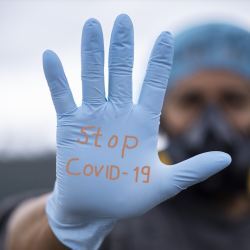We're learning more every day about the SARS-CoV-2 virus, but it will likely present surprises. The best strategy is still to prevent new infections.

Donald Rumsfeld, the two-time secretary of defense (Gerald Ford and George W. Bush administrations), is perhaps best remembered for a response he gave to a question during a 2002 news conference:
As we know, there are known knowns; there are things we know we know. We also know there are known unknowns; that is to say we know there are some things we do not know. But there are also unknown unknowns—the ones we don’t know we don’t know.
Some commentators thought this was gibberish, but there is wisdom in it, and it has application to the state of our knowledge – and uncertainty -- about the possible evolution of the COVID-19 pandemic.
Let us explain.
There are numerous sources for known knowns, including the CDC, scientific journals, major news organizations, and, of course ACSH. We know, for example, the daily tallies and trends of COVID-19 confirmed cases, hospitalizations, and deaths.
And then there are the known unknowns, such as what fraction of the tens of millions of Americans infected with the Omicron variants of the SARS-CoV-2 virus will go on to experience post-COVID-19 syndrome, or “Long COVID,” which is marked by signs or symptoms that persist for more than four weeks, and often much longer, after the diagnosis of infection. If the incidence is anywhere near the 10-30% following Alpha and Delta SARS-CoV-2 infections, our healthcare system will be stressed to the breaking point and costs will skyrocket (to say nothing of the suffering of afflicted individuals). In May of last year, British health economists estimated that COVID-induced disability could account for roughly 30% of the pandemic’s overall health burden. More recent estimates suggest that disability will account for an even greater proportion.
Other known unknowns include the timing of the appearance of new “variants of concern” and what they’ll be like with respect to transmissibility, virulence, and the ability to escape from the immunity conferred by previous infection or vaccination. Every SARS-CoV-2 infection results in viral replication, the creation of new mutants and the opportunity for Darwinian evolution to test them for “fitness” – that is, for greater transmissibility and ability to evade immune defenses. In the U.S., there are more than 19 million children under the age 5 for whom there is no approved vaccine, and tens of millions of other people have not been vaccinated. Currently, we rank 67th in the world for being “fully vaccinated” and 54th for having its population get a booster shot that preserves a high level of protection against hospitalization and death. This creates the potential for new variants.
In addition to the known unknowns, or hard-to-predict probabilities of the various events described above, there are also unknown unknowns in the world of virus-caused diseases. However, we can speculate about some of these. For example, coronaviruses are commonplace in animals, and there is a disturbing example in cats of a variation on the “Long COVID” phenomenon. They can develop a deadly disease called Feline Infectious Peritonitis (FIP), which occurs long after cats are exposed to a coronavirus, usually at a young age while still in the shelter or cattery.
Feline coronaviruses infect 40%–80% of all cats worldwide, most commonly in animals under two years of age. It typically causes only mild diarrhea or no symptoms at all, and usually goes away as young cats mature and develop immunity. However, in 5% to 10% of cases, a mutation occurs in the virus, which then infects the cat’s white blood cells, carrying the infection throughout the body and triggering an intense immune system response in the affected tissues, such as the brain or gastrointestinal system. Untreated, the disease has nearly a 100 percent mortality rate. We have seen a similar phenomenon in human disease: Decades after the polio vaccines almost eliminated the disease, a proportion of survivors relapsed with post-polio syndrome.
There is an interesting nexus between feline coronaviruses and the SARS-CoV-2 virus in humans. An experimental drug, GS-441524, that has shown significant efficacy in reversing the symptoms of FIP, is closely related to remdesivir, a drug that is approved by the FDA for hospitalized COVID-19 patients. (Both are produced by Gilead Sciences.)
There is an important lesson here: The best strategies are those that prevent becoming infected in the first place, so for now, the most prudent course is still to get vaccinated, boosted, and take other reasonable precautions to “flatten the curve” of infections. The fewer infections, the less viral replication, the fewer mutants, and the less likelihood of new, worse variants.
Henry I. Miller, a physician and molecular biologist, is a senior fellow at the Pacific Research Institute. He is the co-discoverer of a critical enzyme in the influenza virus. Melissa Hart, DVM, is a practicing veterinarian in Sonoma, California.
